Must-Try El Salvador Foods for an Authentic Taste!
El Salvador’s cuisine is a rich blend of tradition, culture, and flavor. From savory dishes to sweet treats, El Salvador food offers a wide variety of foods that are perfect for anyone looking to experience authentic Salvadoran tastes. Whether you’re planning a trip and wondering what to eat in El Salvador or exploring its flavors from home, these typical food in El Salvador options will give you a true taste of the country.
- Pupusas: El Salvador’s national dish, these delicious stuffed tortillas come with a variety of fillings, like cheese, beans, and pork.
- Tamales: Steamed corn dough filled with meat, vegetables, or even sweet ingredients, offering a comforting meal.
- Yuca con Chicharrón: A flavorful dish with fried yuca (cassava) and crispy pork, combining both textures and tastes.
- Torta: A Salvadoran sandwich made with fresh bread and filled with savory ingredients like meat and pickled vegetables.
These dishes are just the beginning! Dive into the heart of Salvadoran food, and you’ll find a world of unique flavors waiting to be explored. From the most iconic dishes from El Salvador like pupusas to seasonal specialties, these are truly the popular foods in El Salvador that every visitor should try. On this site, you will find everything you need to know about El Salvador.
Best El Salvador Foods
Salvadoran food isn’t just about taste—it’s a reflection of the country’s rich culture, history, and traditions. Writers like Karla T. Vasquez, featured in Salon, document how Salvadoran women have preserved recipes and traditions across generations, connecting the diaspora to its roots.
Many of the famous foods from El Salvador are tied to family gatherings, street food traditions, and celebrations. Every dish has a story, deeply connected to the people, their land, and their way of life. From family gatherings to street food stalls, Salvadoran foods plays an essential role in Salvadoran culture, bringing people together and preserving the country’s heritage.
The Cultural Significance of Salvadoran Food
El Salvador culture food is more than just nourishment—it’s a vital part of the country’s identity. Here’s why Salvadoran food is so culturally significant:
- Connection to the Land: Many traditional dishes are made with locally grown ingredients like corn, beans, and fresh vegetables, highlighting the importance of agriculture in Salvadoran life.
- Celebration of Community: Meals are often enjoyed with family and friends, especially during special occasions like holidays and festivals. Together Women Rise notes that food is central to Salvadoran identity, serving as a way to strengthen family bonds and celebrate local harvests.
- Tradition Passed Down: Recipes like pupusas have been shared for generations, making them central to El Salvador traditional food culture.. Dishes like pupusas have been enjoyed for centuries and continue to be a symbol of Salvadoran pride.
- Festive Dishes: Certain foods, such as tamales and Panes con Pavo, are specifically prepared for festivities, signifying their role in important cultural celebrations and rituals.
In El Salvador, food is not just eaten—it’s celebrated, cherished, and shared. It represents a deep sense of pride and a connection to the past, ensuring that the flavors of El Salvador continue to thrive in the hearts of its people. For anyone exploring El Salvador popular food or curious about the typical food of El Salvador, these traditions highlight how deeply cuisine is tied to culture.
Core Staples of Salvadoran Culinary Tradition
Salvadoran cuisine is built around a few key dishes that have become beloved staples. These dishes represent the heart and soul of the country’s culinary tradition, offering a blend of flavors and textures that make them unforgettable.
Pupusas: El Salvador’s Beloved National Dish
Pupusas are the most iconic and beloved dish in El Salvador. These thick, hand-made tortillas are filled with a variety of savory ingredients and then cooked on a griddle. According to Wikipedia’s Pupusa entry, this national dish dates back to pre-Columbian times and remains a symbol of Salvadoran pride today. Some of the most iconic El Salvador dishes include:
- Cheese and beans: A simple but tasty combination that’s a staple in many Salvadoran homes.
- Pork (chicharrón): A flavorful, crispy filling made from slow-cooked pork.
- Revuelta: A mix of cheese, beans, and pork, offering a savory burst of flavor.
These are the heart of Salvador foods, offering the perfect introduction to local flavors. Pupusas are often served with curtido, a tangy cabbage slaw, and salsa roja, a mild tomato sauce. It’s common to see locals enjoying them at family gatherings, street food stalls, or as part of a celebration.
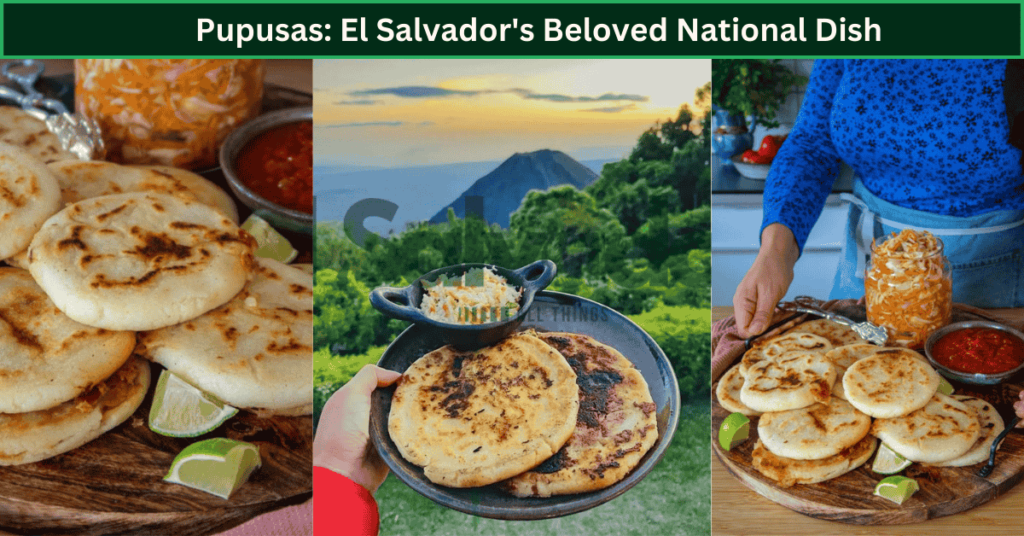
Tamales: Steamed Delights Wrapped in Tradition
Tamales are another favorite in Salvadoran cuisine, often prepared during festive occasions. As noted by Wikipedia on Tamales, these corn-based dishes originated in ancient Mesoamerica and have countless regional variations, with El Salvador specializing in tamales de elote and tamales pisques. Made from corn dough, these tamales are filled with a variety of savory or sweet fillings, such as:
- Chicken or pork: Wrapped in corn husks and steamed to perfection.
- Sweet tamales: Filled with cinnamon and sugar, often served for dessert.
Tamales are typically served with a warm drink like atol de elote (corn-based drink), making them a comforting meal for any time of the day.

Yuca con Chicharrón: A Fusion of Flavors
Yuca con Chicharrón is a delicious and hearty dish that combines the starchy, soft texture of yuca (cassava) with the crispy, savory goodness of chicharrón (fried pork). The dish is usually served with a side of tomato salsa or curtido to balance the richness of the pork. It’s a popular comfort food in El Salvador, loved for its perfect mix of textures and flavors.
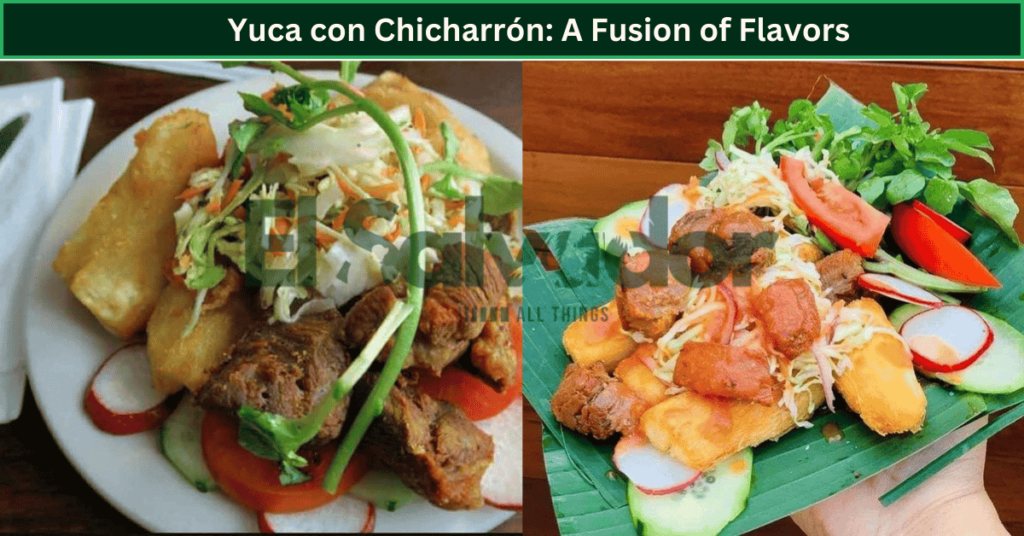
Torta: The Salvadoran Sandwich Experience
A torta is a Salvadoran sandwich that offers a unique twist compared to typical sandwiches found elsewhere. Made with fresh, soft bread, these sandwiches are filled with an array of delicious ingredients such as:
- Steak, chicken, or pork: Savory meats, often grilled or fried.
- Pickled vegetables: Adding a tangy, crunchy texture.
- Avocado: A creamy addition that complements the other fillings.
Tortas are often eaten for breakfast, lunch, or dinner and are a great way to experience the flavors of Salvadoran cuisine on the go. They’re especially popular in casual eateries and street food stalls.
El Salvador dishes are at the heart of the country’s rich culinary tradition, and no visit—or deep dive into its culture—is complete without experiencing them firsthand.
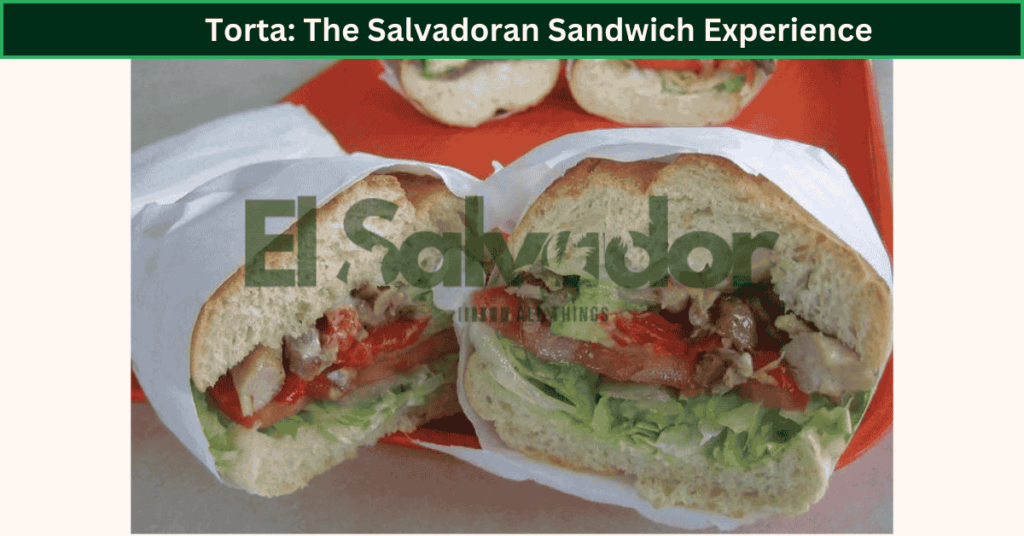
Traditional Breakfasts and Street Foods
El Salvador Food includes a variety of breakfast dishes and street foods that are both hearty and flavorful. Food in El Salvador is perfect for starting the day or enjoying a quick, delicious snack while out and about.
Desayuno Típico: A Hearty Salvadoran Breakfast
The Desayuno Típico is a traditional Salvadoran breakfast that’s perfect for fueling up in the morning. This hearty meal typically includes:
- Scrambled eggs: Cooked with tomatoes, onions, and sometimes peppers.
- Fried plantains: Sweet and crispy, adding a delicious contrast to the other savory items.
- Refried beans: A creamy side dish often served with cheese and sour cream.
- Pupusas: Sometimes included for an extra dose of Salvadoran flavor, making the breakfast even more filling.
Desayuno Típico is often enjoyed with a warm drink like coffee or horchata (a traditional rice-based drink), offering a comforting start to the day.

Elote Loco: A Spicy Street Corn Snack
Elote Loco is a popular street food snack in El Salvador. This flavorful treat features grilled corn on the cob, which is smothered with a variety of toppings to give it an irresistible taste. Some common toppings include:
- Mayonnaise: Giving the corn a creamy texture.
- Cheese: Typically a crumbly, salty variety.
- Hot sauce: For a spicy kick.
- Lime: A fresh citrusy finish to balance the flavors.
Elote Loco is a favorite among locals and visitors alike, often served at food stalls or street corners, making it a perfect on-the-go snack.
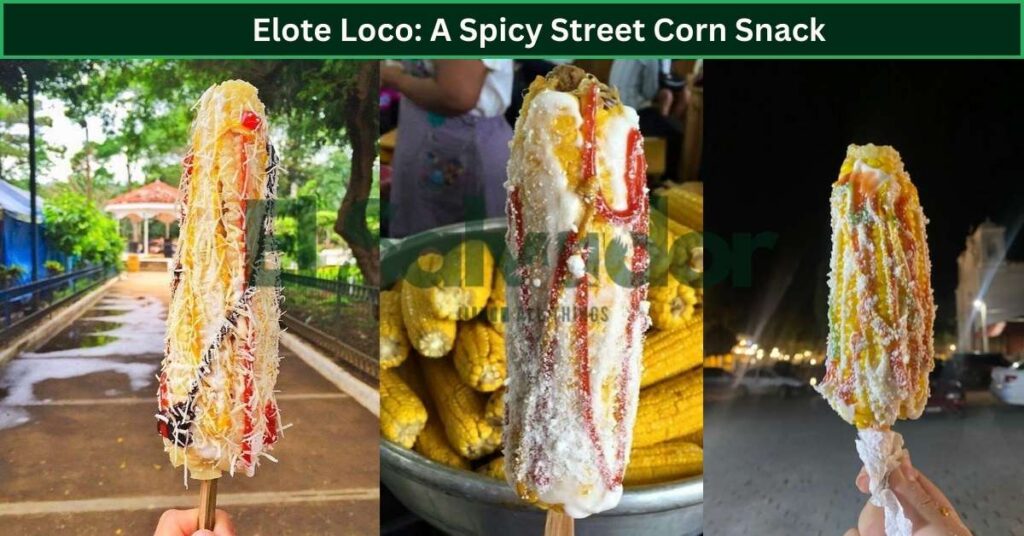
Loroco: The Floral Essence in Salvadoran Dishes
Loroco is a unique and fragrant edible flower that is often used in Salvadoran cooking. With a mild, slightly earthy flavor, loroco is used to enhance a variety of dishes, including:
- Pupusas: Loroco is often added as a filling, giving the dish a distinctive taste.
- Tamales: It can be mixed with other ingredients for a more aromatic and floral flavor.
Loroco is beloved for its versatility and is a symbol of the Salvadoran love for fresh, local ingredients.

Fried Plantains, Potatoes, and Yuca: Comfort Foods
Fried plantains, potatoes, and yuca are staples in Salvadoran comfort food. These dishes are simple, satisfying, and often served as sides with other meals or as snacks. Here’s a breakdown of each:
- Fried Plantains: Sweet and crispy, plantains are fried to perfection and served as a side or snack.
- Fried Potatoes: Crispy, golden fries are a favorite, often eaten with a sprinkle of salt or served with dips.
- Fried Yuca: Yuca is a starchy root vegetable that, when fried, becomes crispy on the outside and soft on the inside.
These comfort foods are often enjoyed with curtido (a tangy cabbage slaw) or salsa roja, and are the perfect accompaniment to a variety of Salvadoran meals.
Together, these traditional breakfasts and street foods offer a delicious and diverse look into Salvadoran culinary culture, giving you a taste of both home-cooked meals and street food delights.

Exploring the Meats of El Salvador
Meat plays a big role in El Salvador Food, with bold, smoky, and rich flavors that stand out in every bite. From grilled meats to traditional sausages, Salvadoran dishes offer a variety of delicious options for meat lovers.
Grilled Meats: Savoring the Smoky Flavors
Grilled meats are a central part of Salvadoran dining, and they are often cooked over an open flame, imparting a smoky flavor that makes them irresistible. Common grilled meats include:
- Beef steaks: Tender cuts of beef, marinated with spices and grilled to perfection.
- Pork chops: Juicy and flavorful, often seasoned with a mixture of garlic, citrus, and other spices.
- Chicken: Grilled whole or in pieces, usually marinated in a tangy, savory sauce.
Grilled meats are usually served with sides like rice, beans, fried plantains, and salsa, making for a hearty and satisfying food in El Salvador.
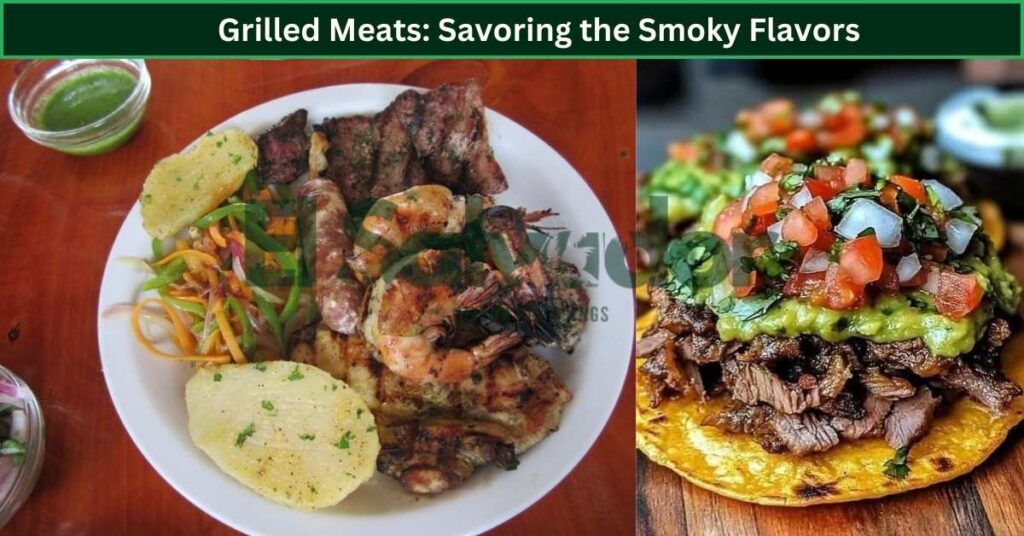
Chorilonza: The Spicy Sausage Delight
Chorilonza is a spicy Salvadoran sausage made from pork and seasoned with a blend of spices and herbs, giving it a bold, flavorful taste. It’s often grilled or fried until crispy on the outside while remaining tender on the inside. It’s typically enjoyed as:
- A snack: Often served on its own, sliced, and paired with curtido (cabbage slaw).
- As a topping: Added to dishes like pupusas or tortas for an extra burst of flavor.
Chorilonza is beloved for its spicy kick and rich, savory taste, making it a must-try for meat lovers in El Salvador.

Iguana: A Unique Culinary Experience
Gallo en Chicha is a traditional chicken dish cooked with chicha, a fermented corn beverage. Wikipedia highlights its deep roots in Salvadoran culinary heritage, where it’s often prepared for family gatherings and festive occasions.It is typically:
- Slow-cooked: Usually stewed in a flavorful broth with tomatoes, onions, and spices.
- Grilled: Sometimes grilled on the bone for a smoky flavor.
Iguana meat is often served with rice, beans, and tortillas, offering a truly unique Salvadoran culinary experience. Although not commonly found everywhere, it is still enjoyed in rural areas and during special occasions.
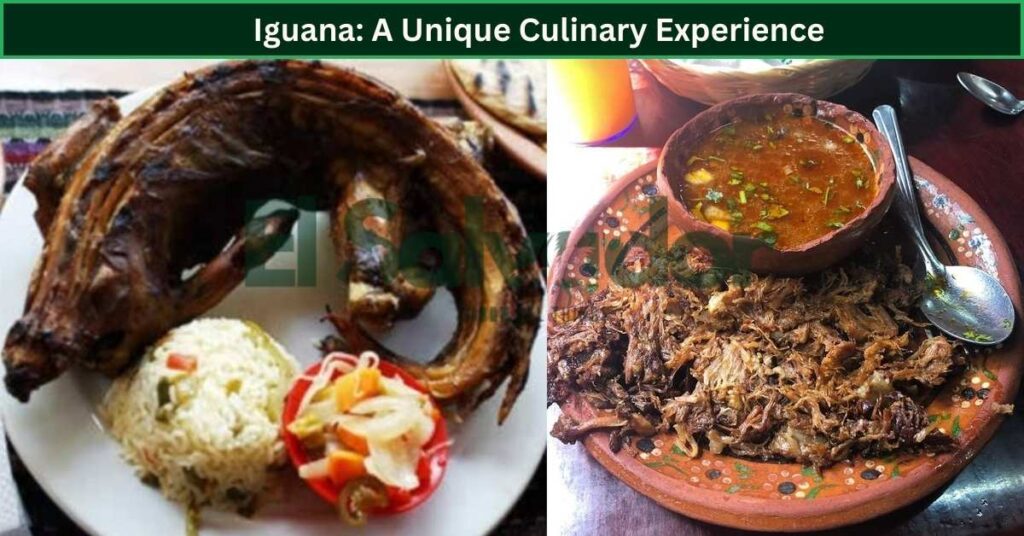
Conejo (Rabbit): Traditional Meat Dishes
Conejo, or rabbit, is another traditional meat dish in El Salvador, prepared in various ways to highlight its delicate flavor. It’s usually:
- Stewed: Cooked in a savory broth with vegetables and herbs for a rich, tender result.
- Grilled: Often marinated with spices and grilled to a crispy perfection.
Rabbit dishes are usually accompanied by rice or fried plantains and are considered a hearty, flavorful meal. Conejo is a popular dish in rural regions, where hunting and farming have kept this tradition alive.
Salvadoran meats are celebrated for their bold flavors and diverse preparations. Whether you enjoy smoky grilled meats, spicy sausages, or more adventurous choices like iguana and rabbit, these dishes showcase the depth and variety of El Salvador’s culinary landscape.
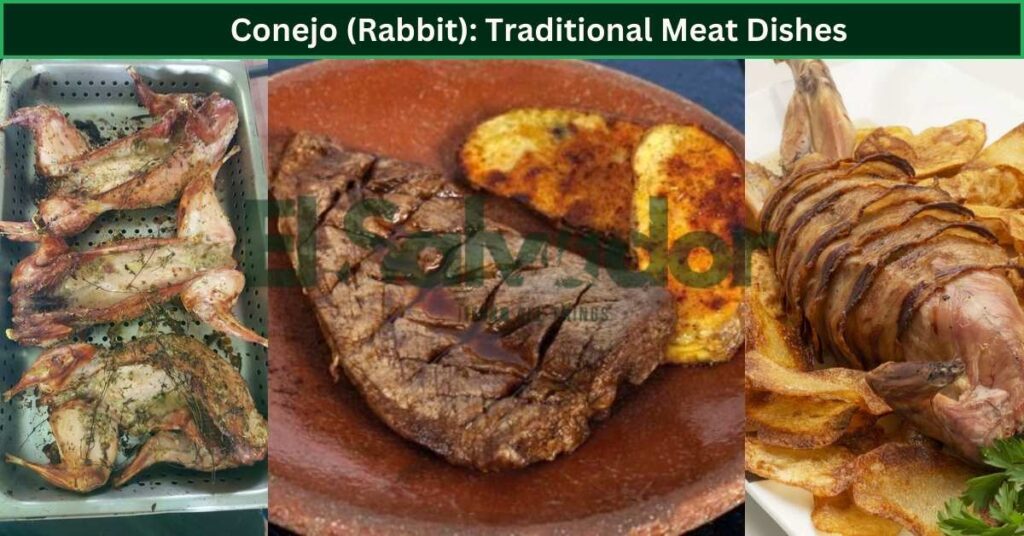
Hearty Soups and Stews of El Salvador
Salvadoran soups like Sopa de Gallina India, Sopa de Pata, and Mondongo are staples of El Salvador traditional food culture. These dishes often combine fresh, local ingredients with rich broths to create hearty meals that warm the soul.
Sopa de Gallina India: A Nutritious Chicken Soup
Sopa de Gallina India is a traditional Salvadoran chicken soup made with free-range hens (gallina india), which are known for their richer, more flavorful meat. This soup is both nutritious and hearty, typically served with:
- Vegetables: Potatoes, carrots, corn, and sometimes squash.
- Herbs and spices: Such as cilantro and garlic, which add depth and aroma to the broth.
- Rice: Often added to make the soup more filling.
The broth is simmered slowly, allowing the chicken to become tender and infuse the soup with a robust flavor. This dish is often enjoyed as a comforting meal, especially during family gatherings.

Sopa de Pata: A Rich Cow’s Foot Soup
Sopa de Pata is a rich and flavorful soup made from cow’s feet, a delicacy in El Salvador. This dish has a unique texture, thanks to the gelatinous collagen from the bones. It’s usually cooked with:
- Vegetables: Includes ingredients like potatoes, carrots, and corn.
- Herbs and spices: Garlic, oregano, and bay leaves give it a distinctive taste.
- Tripe: Some variations of the soup include tripe, adding more flavor and richness to the dish.
The long cooking time allows the cow’s feet to release all of their natural flavors, resulting in a thick, savory broth. Sopa de Pata is often served with tortillas or rice to complete the meal.
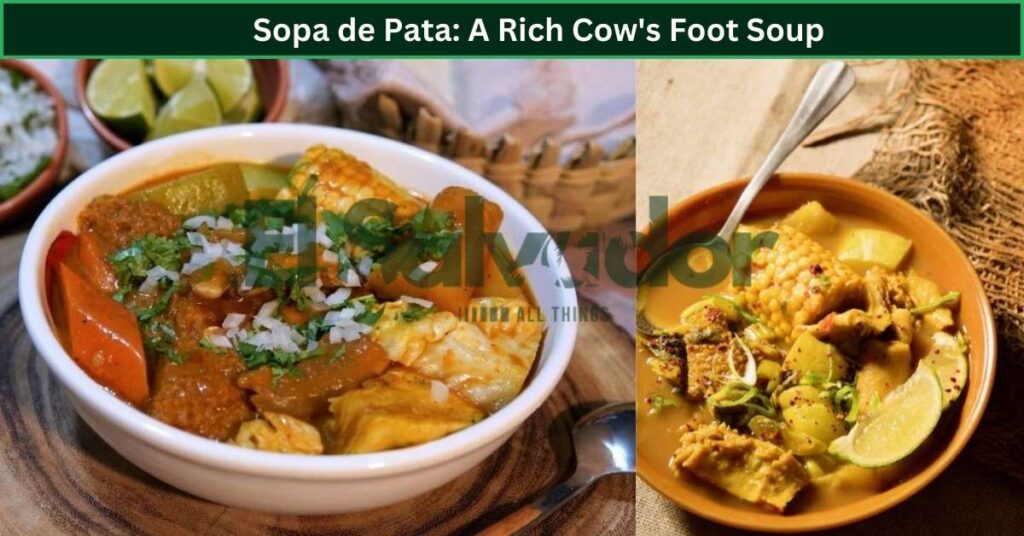
Mondongo: A Flavorful Tripe Stew
Mondongo is a savory, hearty stew made from beef tripe (stomach lining), and it’s considered a comfort food in Salvadoran cuisine. The dish is simmered for hours to achieve a deep, rich flavor and is often prepared with:
- Vegetables: Carrots, potatoes, and corn are common additions.
- Herbs and spices: Garlic, cilantro, and chili peppers infuse the broth with a warming, flavorful kick.
- Homemade broth: The tripe is slow-cooked in a savory broth, making the dish both tender and aromatic.
Mondongo is typically enjoyed as a filling, satisfying meal, and is often served with rice or tortillas. Its hearty nature makes it perfect for family meals or special gatherings.
Salvadoran soups and stews like Sopa de Gallina India, Sopa de Pata, and Mondongo offer a taste of the country’s culinary tradition, featuring rich flavors, tender meats, and nourishing ingredients. These dishes are sure to warm both your heart and your stomach!

Coastal Inspirations – Salvadoran Seafood
El Salvador’s coastal region offers a bounty of fresh seafood, celebrated for its simple yet delicious preparations. From fried fish to ceviche, Salvadoran seafood reflects the vibrant flavors of the Pacific Ocean and provides a refreshing experience for seafood lovers.
Fried Fish: A Simple Coastal Favorite
Fried fish is one of the most beloved seafood dishes in El Salvador. Typically made with whole fish like tilapia or snapper, this dish is easy to prepare and highlights the fresh flavors of the ocean. Here’s how it’s usually served:
- Golden and crispy: The fish is seasoned, coated in flour, and deep-fried until crispy on the outside and tender on the inside.
- Accompaniments: Often served with rice, fried plantains, or salad for a well-rounded meal.
- Simple seasoning: The fish is usually seasoned with salt, garlic, and lime, allowing the natural flavors to shine through.
Fried fish is a perfect beachside dish, often enjoyed with a cold drink while taking in the coastal views.
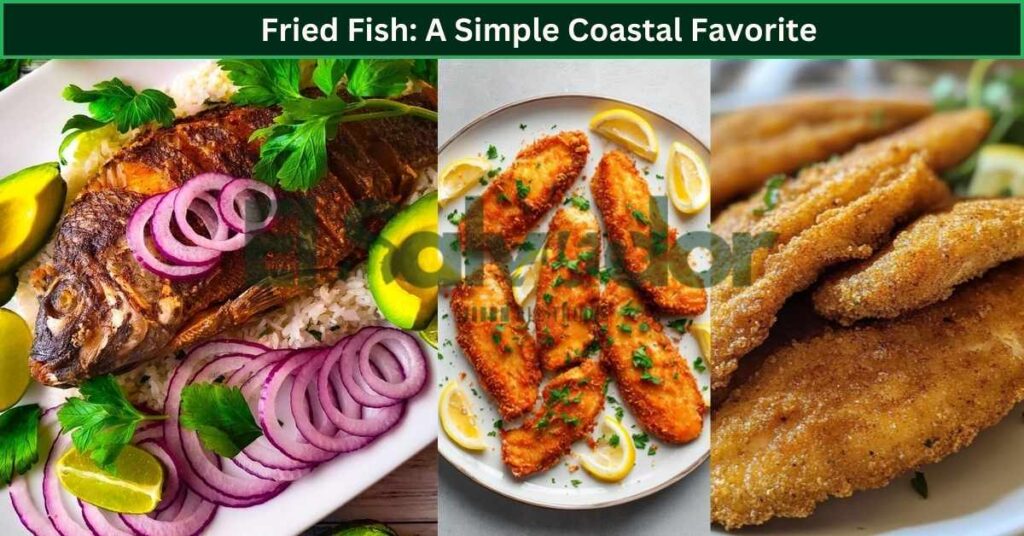
Black Clams: A Taste from the Sea
Black clams (known as almejas negras) are a popular seafood item in El Salvador, especially in coastal areas. These clams are harvested from the ocean and are appreciated for their tender meat and briny flavor. They are typically prepared in a few different ways:
- Steamed or grilled: The clams are often steamed or grilled, allowing their natural juices to combine with seasonings and herbs.
- In soups: Black clams are sometimes added to broths, adding a rich, savory depth to the soup.
- Topped with garlic and lemon: A popular preparation is to serve them with a garlic-based sauce and a squeeze of fresh lime for a zesty kick.
Black clams are a true taste of the sea, and their delicate texture makes them a favorite among seafood aficionados.
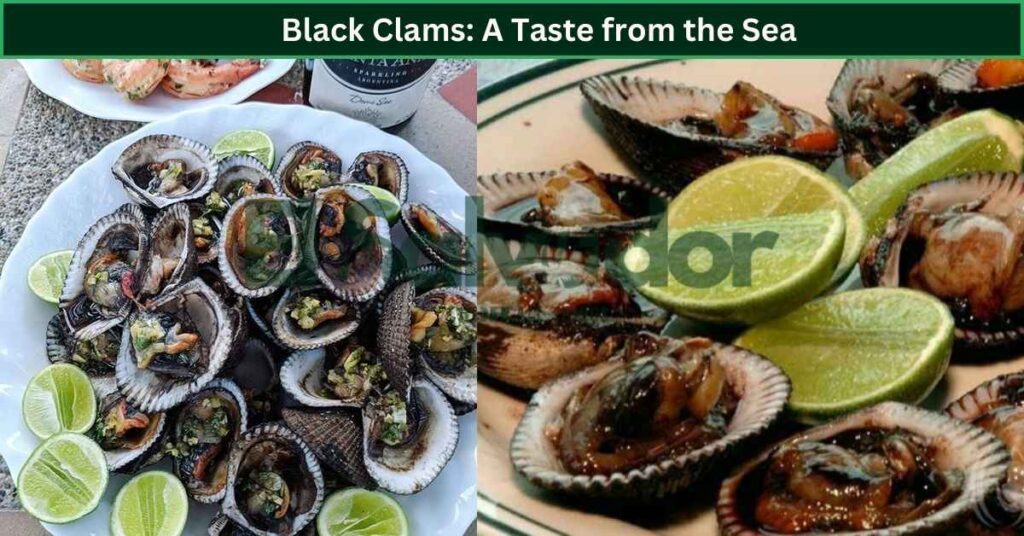
Cocteles & Ceviche: Fresh and Zesty Seafood Mixes
Cocteles and ceviche are refreshing, zesty seafood dishes perfect for hot days. Both dishes feature fresh, raw seafood marinated in citrus juice, bringing out the natural flavors of the ingredients. Here’s what makes them special:
- Cocteles: These are seafood cocktails made with shrimp, clams, or fish mixed with tomato sauce, lime juice, onions, cilantro, and avocado. It’s often served cold, making it a perfect appetizer or light meal.
- Ceviche: Ceviche in El Salvador typically consists of raw fish or shrimp marinated in lime juice and mixed with chopped onions, cilantro, tomatoes, and chili peppers. It’s tangy, refreshing, and full of flavor.
Both dishes showcase the bright, vibrant flavors of fresh seafood, and they’re often enjoyed as appetizers or snacks at beachside eateries.
El Salvador’s coastal seafood dishes—whether it’s fried fish, black clams, or zesty cocteles and ceviche—offer a delightful taste of the ocean. They are fresh, simple, and packed with the vibrant flavors of the sea.

Seasonal and Festive Delicacies
El Salvador Food includes a range of seasonal and festive dishes that add special flavor to holidays and celebrations. From mushrooms that appear only at certain times of the year to traditional sandwiches enjoyed during festivals, these dishes offer a taste of Salvadoran culture and seasonal abundance.
Tenquique Mushrooms: A Seasonal Treat
Tenquique mushrooms (also known as tenquiques) are a seasonal delicacy in El Salvador, often found during the rainy season. These mushrooms are highly valued for their unique flavor and are typically harvested in the wild. Here’s what makes them special:
- Flavor: Tenquique mushrooms have a rich, earthy flavor that pairs well with both meat and vegetable dishes.
- Cooking methods: They are usually sautéed with onions, garlic, and herbs, or added to soups and stews for extra depth.
- Limited availability: These mushrooms are only available during certain months of the year, making them a highly anticipated treat when in season.
Tenquique mushrooms are cherished for their fresh, wild taste, and their seasonal nature makes them a true delicacy in Salvadoran cuisine.
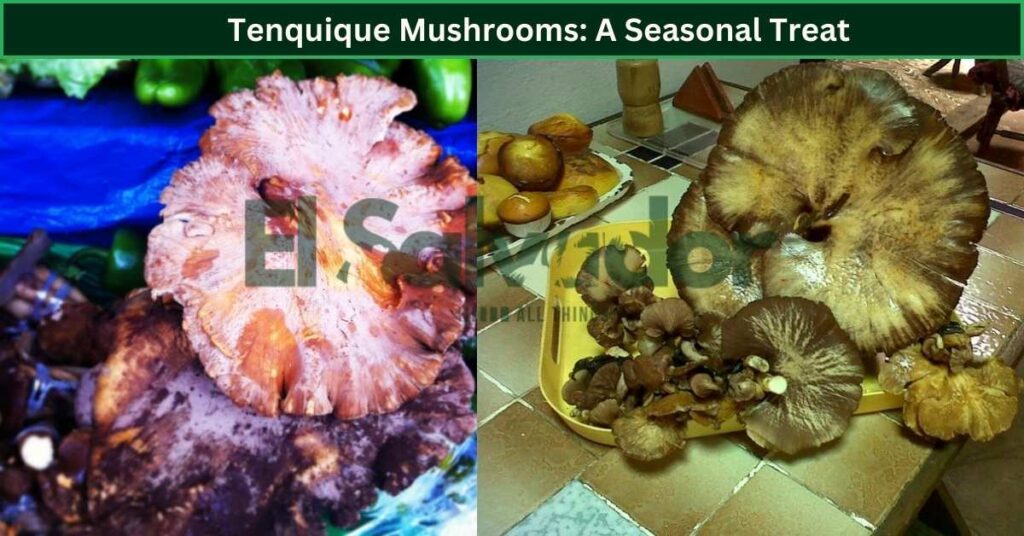
Panes con Pavo: Traditional Turkey Sandwiches
Panes con Pavo is a traditional Salvadoran sandwich often enjoyed during festive seasons, especially around Christmas and New Year. It features roast turkey as the star ingredient, combined with a variety of flavorful accompaniments:
- Tender turkey: The turkey is marinated with spices and herbs, slow-roasted to perfection, resulting in a juicy, flavorful meat.
- Bread: The sandwich is typically made with a soft bolillo or French bread roll that holds the turkey and its fillings.
- Toppings: Common toppings include tomatoes, avocados, pickled vegetables, and salsa roja, adding a burst of color and flavor.
- Festive dish: This sandwich is often served during holiday gatherings and celebrations, making it a special treat enjoyed by families and friends.
Panes con Pavo is not just a sandwich; it’s a part of Salvadoran tradition, bringing people together during the holiday season for a delicious, comforting meal.
In El Salvador, seasonal and festive dishes like Tenquique mushrooms and Panes con Pavo offer a taste of the country’s culture, bringing together unique ingredients and flavors that mark special occasions throughout the year.
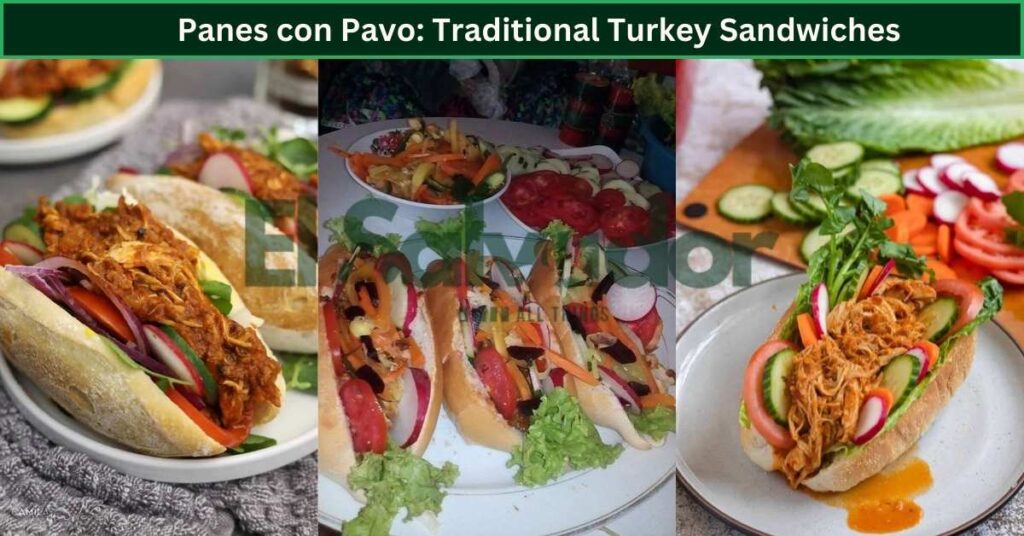
Decadent Desserts of El Salvador
El Salvador offers a variety of sweet treats that reflect the country’s rich culinary heritage. According to Wikipedia’s article on Nuegado, these treats are especially popular during Holy Week and showcase the blend of indigenous and Spanish culinary traditions.
From moist plantain cakes to savory rice-flour poundcakes, Salvadoran desserts are a delightful mix of flavors and textures that will satisfy any sweet tooth.
Pastel de Plátano: A Sweet Plantain Cake
Pastel de Plátano is a beloved Salvadoran dessert made with ripe plantains. This cake is both sweet and moist, making it the perfect treat for those who enjoy fruity desserts. Here’s what makes it special:
- Main ingredient: The star of this cake is the plantain, which is mashed and blended into the batter to create a naturally sweet and moist texture.
- Flavors: The cake is often flavored with cinnamon, vanilla, and a touch of clove, adding warmth and depth to its sweetness.
- Topping: It’s typically finished with a light dusting of sugar or cinnamon on top for a little extra sweetness.
- Served warm: This cake is often served warm, making it the perfect comfort dessert after a hearty meal.
Pastel de Plátano is a delicious and comforting dessert that celebrates the flavors of ripe plantains in a simple yet satisfying way.
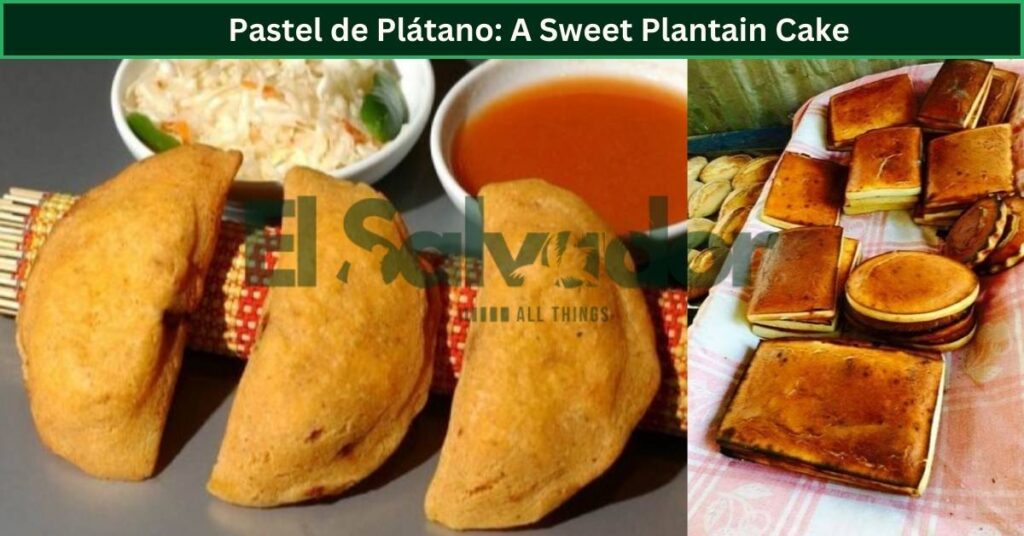
Quesadilla: A Savory Rice-Flour Poundcake
Quesadilla is a unique Salvadoran dessert that’s quite different from the typical sweet treats. It’s a savory rice-flour poundcake that combines rich, buttery flavors with a slightly crumbly texture. Here’s what you need to know about it:
- Savory twist: Despite its name, quesadilla is not a cheese-filled snack. It’s a dense, moist cake made with rice flour, butter, and cheese, giving it a slightly savory taste.
- Texture: The cake is soft and crumbly with a golden crust, offering a comforting and slightly hearty texture.
- Flavor: The cake has a subtle cheese flavor, complemented by a hint of vanilla and cinnamon, making it an interesting balance of savory and sweet.
- Toppings: It is sometimes topped with sesame seeds, adding a delightful crunch.
Quesadilla is often enjoyed as a snack or dessert, perfect for pairing with coffee or a warm drink. It’s a treat that brings a unique blend of savory and sweet, offering something different from typical cakes.
Salvadoran desserts like Pastel de Plátano and Quesadilla are deliciously diverse, combining sweet, savory, and comforting flavors to create memorable end-of-meal experiences.
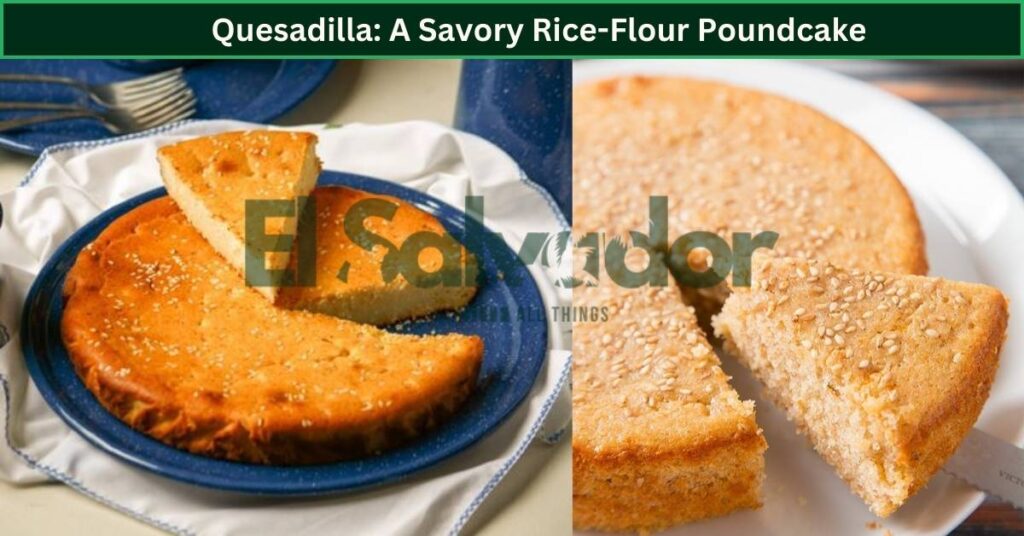
Refreshing Beverages and Spirits
Salvadoran beverages reflect the country’s cultural diversity and offer a wide range of refreshing flavors. From craft beers to sweet, spiced drinks, Salvadorans know how to pair their meals with delicious drinks that are both satisfying and full of character.
Salvadoran Craft Beer: Brewing Traditions
Salvadoran craft beer has been gaining popularity in recent years as local breweries have begun experimenting with different styles and flavors. Here’s what makes Salvadoran craft beer stand out:
- Variety: Breweries across El Salvador offer a wide range of craft beer options, from light lagers to rich stouts and hoppy IPAs.
- Local ingredients: Many Salvadoran craft beers use local ingredients like maize, tropical fruits, and coffee to create unique flavors.
- Community-driven: The craft beer scene in El Salvador is still growing, with many small breweries focused on producing high-quality, locally-made beers.
- Pairing: These beers pair wonderfully with traditional Salvadoran dishes like pupusas and grilled meats.
Salvadoran craft beer is an exciting and refreshing way to experience the country’s growing brewing culture.
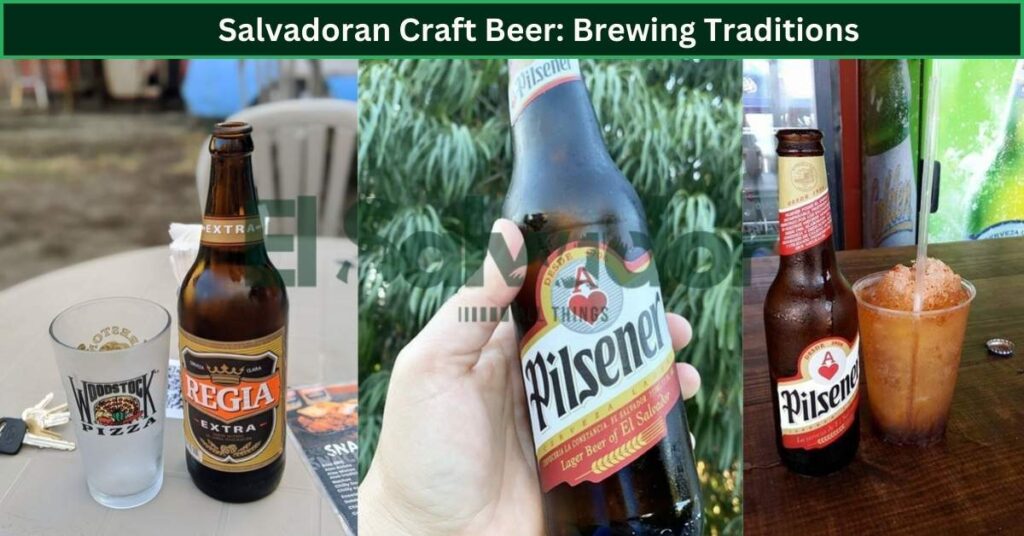
Horchata: A Traditional Rice-Based Drink
Horchata is a traditional Salvadoran drink made from rice, making it both refreshing and nourishing. This beloved beverage is perfect for cooling down on a hot day and has a unique, creamy flavor. Here’s what you should know:
- Main ingredients: Horchata is made with rice, cinnamon, and vanilla, and often sweetened with sugar to taste.
- Flavor profile: The drink is smooth and creamy, with a touch of spice from the cinnamon and a delicate sweetness.
- Chilled treat: Typically served cold, horchata is the perfect drink to accompany meals or to enjoy on its own as a sweet, cooling refreshment.
- Versatility: Some variations of horchata include additional ingredients like almonds or cashews for a richer taste.
Horchata is a beloved drink in El Salvador, offering a sweet and creamy taste of the country’s traditional beverage culture.
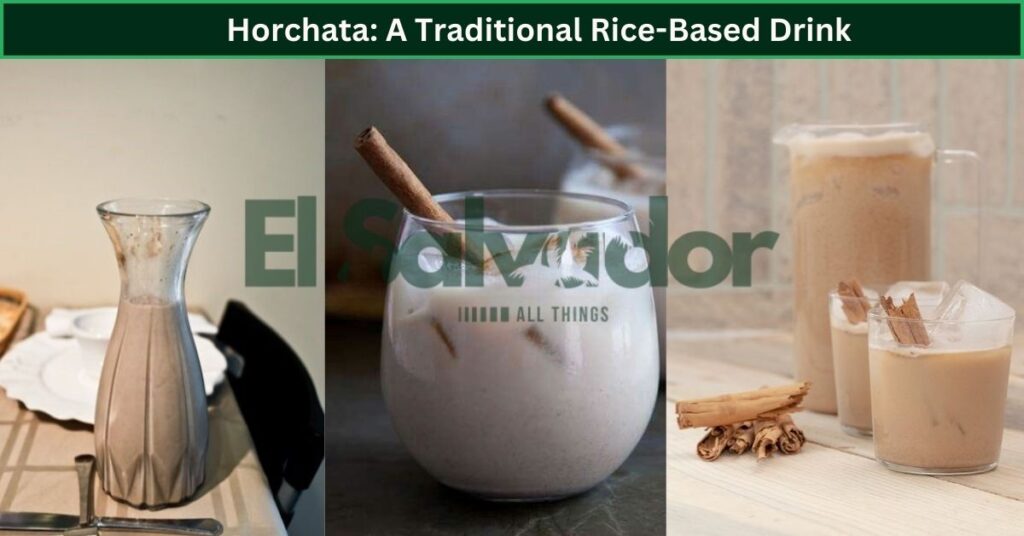
Coffee: The Heart of Salvadoran Mornings
Salvadoran coffee is renowned for its high quality and rich flavor, with the country’s coffee being some of the best in the world. For many Salvadorans, coffee is more than just a drink; it’s a part of their daily ritual. Here’s what makes Salvadoran coffee stand out:
- Grown in high altitudes: El Salvador’s volcanic soil and high-altitude regions provide the perfect environment for growing rich, flavorful coffee beans.
- Flavor profile: Salvadoran coffee is often described as having a balanced flavor with notes of chocolate, fruit, and a hint of nutty undertones.
- Brewing methods: Salvadorans often brew their coffee in traditional methods such as a drip filter or French press, giving the coffee a deep and rich flavor.
- Morning staple: Coffee is an essential part of many Salvadorans’ morning routines, enjoyed with a simple breakfast of panes con pavo or quesadilla.
Salvadoran coffee offers a perfect balance of flavor, tradition, and comfort, making it a must-try for anyone looking to experience the country’s morning culture.
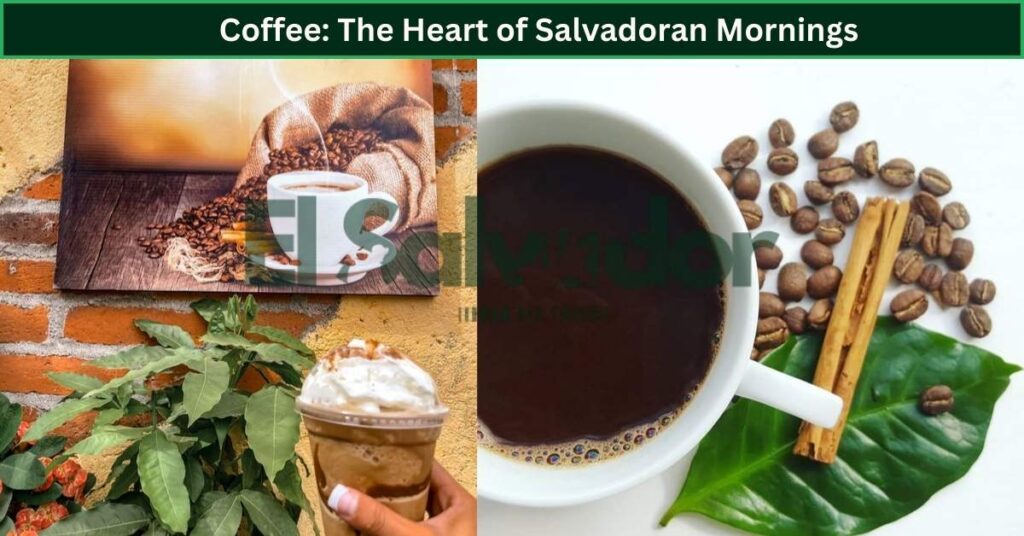
Ponche: A Warm, Spiced Beverage
Ponche is a traditional warm beverage, often enjoyed during the colder months and festive seasons. It’s a spiced drink that’s perfect for cozying up with after a long day. Here’s why ponche is so special:
- Ingredients: Ponche is typically made with fruits, spices like cinnamon and cloves, and sometimes rum or sugar to enhance its warmth.
- Flavor profile: It has a rich, comforting flavor with a nice balance of sweetness and spice.
- Festive drink: Ponche is a popular drink during holidays and celebrations, enjoyed by families and friends while gathered together.
- Varieties: There are many versions of ponche, with some recipes adding pineapple, guava, or apples for extra fruitiness.
Ponche is the ultimate winter drink, bringing warmth and comfort to any gathering.

Salvadoran Rum: A Sip of History
Salvadoran rum is a distinctive part of the country’s spirit culture. It is renowned for its smoothness and rich flavors, making it a perfect drink to savor after a meal or as part of a festive celebration. Here’s what you need to know about Salvadoran rum:
- Distilled from sugarcane: Salvadoran rum is made from sugarcane, a key crop in the country’s agricultural sector.
- Aged to perfection: The best rums are aged in oak barrels, which gives them a smooth and complex flavor with hints of vanilla, spice, and caramel.
- Cultural significance: Salvadoran rum is often enjoyed as a part of cocktails, but can also be served neat or in a simple rum and cola for a refreshing drink.
- Popular brands: There are a few well-known Salvadoran rum brands like Flor de Caña, which is exported globally and celebrated for its smooth, high-quality taste.
A sip of Salvadoran rum offers a taste of the country’s rich history and distillation traditions, making it a perfect way to relax and enjoy the evening.
Salvadoran beverages and spirits, from craft beer and horchata to coffee and rum, offer a delightful way to experience the country’s culture and culinary creativity. Whether you’re sipping a hot ponche or enjoying a refreshing craft beer, these drinks will enhance your Salvadoran culinary journey.

Dining Etiquette and Culinary Customs
Understanding Salvadoran dining etiquette and culinary customs is essential to fully experiencing the country’s vibrant food culture. From how to share meals to the best spots for authentic food, Salvadoran dining traditions create a warm and inviting atmosphere.
Understanding Salvadoran Dining Etiquette
Salvadoran dining etiquette is rooted in respect, family values, and hospitality, a cultural dynamic also highlighted in Iowa HHS’s El Salvador cultural food guide, which emphasizes the importance of family-centered meals. Here’s what you should know when dining in El Salvador:
- Family-centered meals: Meals are often shared with family or friends, reflecting the importance of togetherness. When dining, it’s customary to wait for the eldest or the host to start eating before you do.
- Casual setting: In many places, dining is a relaxed, informal affair, with everyone gathering around the table to enjoy food together. Don’t expect fancy table settings in every home – simple, hearty meals are the highlight.
- Offering food: It’s polite to offer food to others at the table. If you’re invited to someone’s home, always accept their hospitality, even if you’re not particularly hungry, as it’s a sign of respect.
- Hands and utensils: While Salvadorans often use utensils like forks and knives, pupusas, a popular dish, are traditionally eaten with the hands. It’s important to eat with your right hand, as using the left is considered impolite.
- Respecting traditions: When dining at special occasions, such as holidays or family gatherings, expect to see a mix of traditional dishes like pupusas and sopa de gallina india, and always express gratitude for the meal.
Understanding these customs ensures you can engage with Salvadoran dining culture respectfully and enjoy the true essence of the food.
Must-Visit Eateries for Authentic Experiences
If you’re looking to enjoy the best Salvadoran food, there are several places across El Salvador that offer an unforgettable, authentic culinary experience. These eateries highlight the traditional flavors and vibrant food culture of the country. If you’re exploring food in El Salvador, you can’t miss:
- Pupuserías: These small, family-owned restaurants are dedicated to serving the iconic pupusas. Here, you can try a variety of fillings, from cheese and beans to chicharrón (fried pork) and loroco. Some of the best pupuserías are found in towns like Santa Tecla and San Salvador.
- Mercado de San Miguelito (San Salvador): A vibrant food market where you can sample a wide range of traditional Salvadoran foods. Try sopa de gallina india and yuca con chicharrón from the food stalls, or enjoy freshly made tamales.
- Restaurante El Lago (Lake Coatepeque): Located by the beautiful Lake Coatepeque, this restaurant offers both fresh seafood and traditional Salvadoran dishes, including grilled fish and ceviche.
- Comedor Tía Cuca (San Salvador): Famous for its sopa de pata (cow’s foot soup) and pupusas, it’s a great place to stop for lunch in El Salvador, offering authentic home-style dishes packed with flavor.
- La Pampa (Antiguo Cuscatlán): A place to experience grilled meats, tortas, and other barbecue-style dishes, paired with refreshing Salvadoran craft beer.
These are the places to discover El Salvador foods in their most authentic form. Visiting these eateries allows you to taste the very best of Salvadoran cuisine, immerse yourself in the country’s culinary customs, and discover the rich food culture that defines El Salvador.
For the Adventurous Palate
Step beyond well-known El Salvador dishes and try gallo en chicha, atol de elote, or queso de hoja for a deeper look at the country’s culinary traditions. Here’s how you can step outside the usual and explore Salvadoran cuisine beyond the popular picks.
Lesser-Known Dishes to Expand Your Taste
If you’re willing to venture beyond the classics, there are a few Salvadoran dishes that will delight your taste buds with their bold and unique flavors:
- Gallo en Chicha: This is a traditional chicken dish cooked with chicha, a fermented corn beverage. The dish combines the earthy flavor of chicken with the sweet and tangy notes of chicha, giving it a unique taste that reflects Salvadoran cooking traditions.
- Atol de Elote: A warm, creamy corn drink made from fresh corn, milk, and sugar. It’s both a drink and a dessert and offers a rich, sweet flavor that’s perfect for cooler evenings.
- Pipián: A spicy, savory sauce made from pumpkin seeds, tomatoes, and chilies, often served with meats like chicken or pork. It’s an intense, rich dish that’s a treat for those who enjoy bold flavors.
- Chirmol: A tangy tomato-based salsa made with peppers, onions, and cilantro. It’s a common accompaniment to dishes like pupusas or grilled meats and adds a refreshing zest to any meal.
- Queso de Hoja: This is a local cheese made from cow’s milk, often wrapped in banana leaves. It has a soft texture and a mild flavor, perfect for pairing with fresh tortillas or pupusas.
These lesser-known dishes offer a deeper dive into Salvadoran cuisine, showcasing regional flavors and cooking methods that give a fuller picture of the country’s food culture.
Hidden Culinary Gems Across El Salvador
If you’re looking to experience truly authentic Salvadoran cuisine, there are a few hidden gems across the country that are not widely known outside of local circles but are definitely worth seeking out:
- La Palma (Chalatenango): This charming town is home to some incredible hidden eateries that serve dishes like fish ceviche, grilled meats, and fresh pupusas. The food here reflects the flavors of the northern highlands, with a focus on fresh, local ingredients.
- Suchitoto: Known for its beautiful colonial architecture, this town also boasts great food. Try Sopa de Pargo, a red snapper soup that is popular in the coastal regions, or panes con pavo, a turkey sandwich made with homemade bread.
- Ruta de Las Flores: Located in the west of El Salvador, this route is famous for its coffee farms and the rustic food of the region. Enjoy fried fish from Lake Coatepeque or sopa de frijoles (bean soup) while exploring the picturesque towns of Juayúa and Apaneca.
- Ilobasco: This town is known for its handmade pottery, but its food scene is also a must-explore. Be sure to try tamales de elote and pan de muerto, a sweet bread enjoyed during special occasions.
Exploring these hidden culinary gems allows you to taste El Salvador’s regional diversity and discover flavors that aren’t often found in the mainstream tourist spots.
Keep Tasting! Embark on a Flavorful Journey
As you dive deeper into the world of El Salvador food, you’ll find that it offers a perfect blend of traditional flavors, local ingredients, and family-centered meals. The Salvador foods scene is rich, diverse, and full of hidden treasures waiting to be discovered.
So, whether you’re savoring a delicious pupusa, sipping a refreshing glass of horchata, or exploring the coastal seafood delights, there’s always something new and exciting to try in El Salvador.
Start your culinary adventure now, and keep tasting!
FAQ’s
What language is spoken in El Salvador?
The official language of El Salvador is Spanish, spoken by the majority of the population.
What does El Salvador eat for breakfast?
A typical food in El Salvador, many Salvadorans enjoy desayuno típico, which includes eggs, beans, cheese, tortillas, and fried plantains.
What is a traditional drink in El Salvador?
A traditional drink in El Salvador is horchata, a sweet, rice-based drink flavored with cinnamon and sometimes a hint of vanilla.
What is the most famous food in El Salvador?
The most famous food in El Salvador is pupusas. These thick corn tortillas are filled with cheese, beans, and pork, making them not only the national dish but also the answer if you’re wondering what is a popular food in El Salvador.
What is El Salvador best known for?
El Salvador is best known for its pupusas, beautiful beaches, and rich coffee production. It’s also famous for its vibrant culture and history.
What is the traditional food of El Salvador?
The traditional food of El Salvador includes pupusas, a stuffed corn tortilla filled with cheese, beans, and pork. Alongside pupusas, other famous foods in El Salvador include tamales, yuca con chicharrón, and tortas, which are all part of the country’s culinary heritage.
What are some common foods in El Salvador?
Besides pupusas, Salvadorans often enjoy tamales, yuca frita (fried cassava), empanadas, and sopa de res (beef soup). These dishes are staples in everyday meals.
What is a traditional El Salvador Christmas food?
During Christmas, Salvadoran families usually prepare panes con pollo (chicken sandwiches with homemade bread), turkey, tamales, and festive desserts like torrejas. These dishes make holiday celebrations special.
